How To Clean Frigidaire Gallery Refrigerator Coils
How to Avert Refrigerator Repairs
These six maintenance steps will foreclose most refrigerator breakdowns.
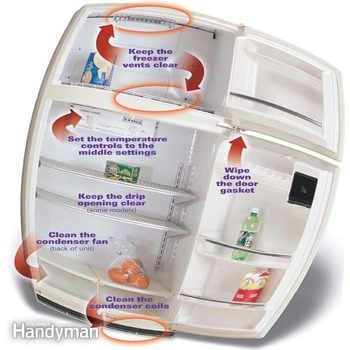
Spend 30 minutes on these simple maintenance steps to go along your fridge running in tip top shape. It'south hard to believe, only six simple maintenance steps volition foreclose almost 100 percent of refrigerator breakdowns and eliminate those service calls. Take these steps and you lot tin forget about spoiled nutrient, lost fourth dimension waiting for repair people and shelling out $lxx an hour plus parts for the repair itself. In this story, we'll show you how to keep your refrigerator humming and trouble-free. And we'll also tell you what to check if a problem does occur.
You might also similar: TBD
- Time
- Complexity
- Cost
- An hour or less
- Beginner
- Costless
Footstep one: Clean the refrigerator condenser coils (5 minutes)
You lot tin eliminate more than 70 per centum of service calls with this simple cleaning step (Photos 1 and 2). Skip this chore and you'll be contributing to your apparatus repair technician's retirement fund. Not to mention handing over $5 to $x a month extra to your utility company because the fridge isn't running efficiently.
Do it twice a year or more often if you lot have shedding pets. Their fur clogs upwardly the coils fast.
Condenser coils are located on the back of the fridge or across the lesser. These coils cool and condense the refrigerant. When the coils are clogged with dirt and dust, they can't efficiently release rut. The result is your compressor works harder and longer than it was designed to, using more free energy and shortening the life of your refrigerator.
Clean the coils with a coil cleaning castor and vacuum. A coil cleaning castor does a thorough job and volition easily pay for itself. The refrigerator gyre castor is bendable to fit in tight areas. They can be used for cleaning your dehumidifier and air conditioner coils besides.
CAUTION:
E'er unplug your fridge earlier working on it!
Footstep two: Clean the refrigerator condenser fan (5 minutes)
If the coils are located on the bottom of the fridge like ours, clean the condenser fan and the area around information technology. (Fridges with coils on the dorsum don't take a fan.) The fan circulates air across the coils to help absurd them. At times, newspaper, clay, grit and fifty-fifty mice can get sucked into the fan and bring information technology to a complete stop.
Photos 1 and 2 show you lot how to clean the fan. Yours could be in a dissimilar area, but information technology's always next to the compressor. Most refrigerators will have a diagram on the back or folded upward under the front end grille showing the location of the major parts. While you're under there, wipe out the drip pan, a flat pan that collects h2o from the defrost wheel and allows it to evaporate.
Step 3: Wipe down the refrigerator door gasket (2 minutes)
Forestall an expensive gasket repair neb ($100 to $200) and cutting down air leaks by keeping your door gasket clean. Syrup, jelly or any other sticky stuff dripping down the forepart sides of your refrigerator tin can dry and gum the gasket to the frame. The next time you open up the door, your gasket tin tear. Keep it clean and you'll go a nice, tight seal, keeping the cool air where it belongs, in the fridge.
To preclude wear, lubricate the door handle side of the gasket by sprinkling infant powder on a cloth and wiping it down once a calendar month.
3 Types of Refrigerators
All refrigerators piece of work on the same principle of cycling refrigerant through two sets of coils. The evaporator coils do the cooling, and the condenser coils release accumulated heat. Where fridges primarily differ is in how they defrost.
A manual defrost is the oldest and simplest type. As the proper name implies, yous defrost these past turning them off and letting all the ice cook. The water and so drips into a pan or runs into the fridge where you wipe it up.
Cycle defrost refrigerators have an evaporator plate in the refrigerator section that warms after each running cycle to eliminate frost buildup. But you have to defrost the freezer manually past turning a dial to the defrost mode. The water in almost models flows into a channel in the dorsum and then downward through a tube to a drip tray nether the fridge.
The frost-free refrigerator, the almost common today, uses a heater to melt ice on the evaporator coils. The heater is turned on by a timer and automatically shuts off. An evaporator fan distributes the cold air through the freezer. Many models have an opening under the crisper drawers to draw water to the baste tray underneath.
Step 4: Articulate the freezer vents (v minutes)
These petty vents on frost-complimentary fridges allow air to circulate in the freezer. Don't block them or let crumbs or twist ties get sucked in around the evaporator fan or clog the drain tube. To help salve free energy, keep your freezer about 3-quarters full to retain cold air. Merely don't pack information technology whatsoever fuller because the air needs to circulate.
Step 5: Ready the refrigerator temperature controls to the heart settings (1 minute)
This step won't necessarily prevent a repair, but it'll extend the life of your fridge by allowing information technology to run more than efficiently, which reduces your electric nib. Your fridge has at to the lowest degree two temperature controls (except on transmission defrost types, which accept one). The one for the food compartment is a thermostat that turns the compressor on and off. The second, for the freezer, is just an air baffle. The baffle lets cold air from the freezer sink into the nutrient compartment. Closing the baffle makes the freezer colder.
Three Means to Go the Olfactory property Out
- Charcoal briquettes absorb the odor just like a filter in a range hood.
- Crumpled newspaper. The ink absorbs the odor.
- Baking soda is the old standby. Leave an open up box in the fridge and replace information technology every three months for continuous deodorizing.
Step 6: Articulate and clean the baste openings (2 minutes)
Drip openings permit h2o that has melted from the defrost cycle to flow down to a pan located by the compressor, where it evaporates. Check your possessor's manual for the location on your fridge. On bike-defrost fridges, a channel directs the water to a tube in the food compartment.
On frost-free refrigerators, await for a small cap under the crisper drawers that covers a pigsty, or an opening in the dorsum of the freezer or refrigerator. If the drain opening clogs, water will build up under the crisper drawers and eventually leak out onto the floor.
Troubleshooting
Service specialists will be the first to acknowledge: A ton of their callers don't crave repair service at all. The solutions are and then like shooting fish in a barrel they don't even crave a toolbox. Earlier yous pick upwardly the telephone, check the following list. Information technology just might save y'all $70 and a fleck of embarrassment.
Got power?
- Bank check the circuit breaker or fuse box to be sure power's coming to the outlet.
- Is the cord plugged in tight? Wiggle it effectually a fiddling. A worn receptacle could let the plug fall out but plenty for the connection to fail.
- Plug a light or whatever other electrical device into the outlet to see if information technology works. If it doesn't, yous've got an electrical problem, not a fridge trouble.
- Check for a loose, worn or frayed power cord. Rodents often chew through a wire. Sometimes cords loosen when the fridge is moved.
What if yous have power but poor cooling?
- Brand sure the thermostat is turned on and set right. On some models the dial is hands bumped, shutting the fridge down. Or kids could have messed with information technology.
Your refrigerator is running all the time merely the food'south still warm.
- Vacuum the coils. Dingy coils can somewhen crusade the overload protector on the compressor to shut the fridge downward. It'll automatically come back on when the compressor cools, but by then your nutrient is commonly warm.
- Is the condenser fan jammed? (This applies only to fridges with the coils on the lesser.) Remove whatever obstacles and make clean it thoroughly. Unplug the fridge and turn it a few times and see if it comes on. If it's nevertheless non working, you'll have to replace information technology.
- Is the light turning off when the door'south closed? That piddling lite seedling can raise the temperature in the fridge substantially. To bank check it, close the door and use a butter knife to pull the gasket slightly abroad from the frame. If low-cal shines out, the switch is bad or slightly out of alignment. Until you fix the switch, loosen the low-cal bulb and then it goes out.
- Look for ice buildup (frost-complimentary fridges but) bulging on the inside walls or the floor of the freezer. Manually defrost the freezer by unplugging it. It'southward only a temporary fix, and so telephone call for service.
Required Tools for this Refrigerator Repair Project
Have the necessary tools for this DIY project lined up before you starting time—yous'll salvage time and frustration.
Coil cleaning brush
Source: https://www.familyhandyman.com/project/how-to-avoid-refrigerator-repairs/
Posted by: stantonexpon1997.blogspot.com

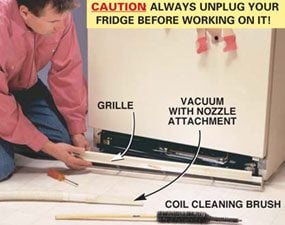

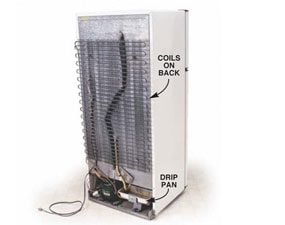
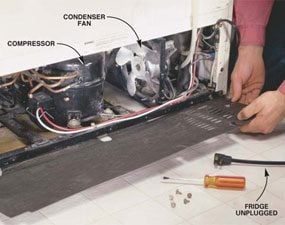

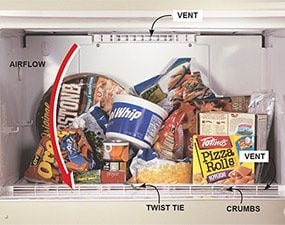
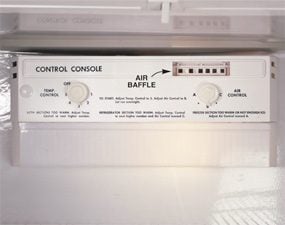
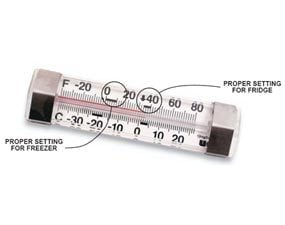
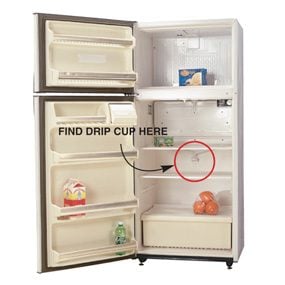
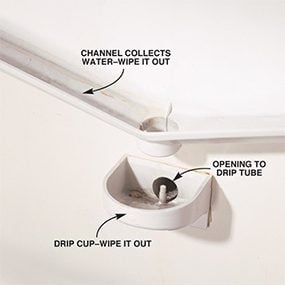

0 Response to "How To Clean Frigidaire Gallery Refrigerator Coils"
Post a Comment